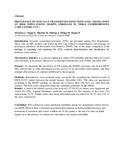| dc.contributor.author | Mwaura, J | |
| dc.contributor.author | Ngugi, E | |
| dc.contributor.author | Nderitu, M | |
| dc.contributor.author | Ndunge, J | |
| dc.contributor.author | Muiga, M | |
| dc.contributor.author | Majau, P | |
| dc.date.accessioned | 2013-12-04T15:49:39Z | |
| dc.date.available | 2013-12-04T15:49:39Z | |
| dc.date.issued | 2013-06 | |
| dc.identifier.citation | Mwaura J., Ngugi E., Nderitu M., Ndunge J., Muiga M., Majau P.;June,2013.Prevalence Of Sexually Transmitted Infections (STIs) Among Most At Risk Populations (MARPS) Enrolled In Thika Comprehensive Care Centre (CCC),presented at the 2nd International Scientific Conference, CHS And KNH, 19th - 21st June 2013. | en_US |
| dc.identifier.uri | http://hdl.handle.net/11295/61820 | |
| dc.description | Prevalence Of Sexually Transmitted Infections (STIs) Among Most At Risk Populations (MARPS) Enrolled In Thika Comprehensive Care Centre (CCC),presented at the 2nd International Scientific Conference, CHS And KNH, 19th - 21st June 2013. | en_US |
| dc.description.abstract | Introduction: Sexually transmitted infections (STIs) are prevalent among Key
Populations. Those who are HIV positive and attend the CCCs are offered a
comprehensive care package on prevention referred to as Prevention with
Positives (PWP). One of the major component of the package is screening and
treatment for STIs, condom demonstration and distribution for purposes of
prevention.
The primary objective is to prevent reinfection, reduce STI morbidity and thus
improve overall care outcomes. A secondary objective is to interrupt transmission
cycle of HIV and other STIs
Purpose: To document the prevalence of STI among the MARPs accessing
care in our DICE. This will provide us with information on the success of our
prevention interventions, and help estimate effectiveness of condoms distributed
by the program
Methods: Retrospective cross-sectional study was done. We examined the
clinical records of DICE (CCC) clients between the period January -December
2012. The data was aggregated according to the MARP typology i.e Female Sex
workers, Men who have sex with men and truckers. The STIs were categorized
using the syndromic guidelines by the MOH.
Results: A total of 80 clinical records were reviewed. 27.5%(22) of clients
were diagnosed and treated for STIs. Vaginal Discharge syndrome accounted
for the majority of the cases (16) representing 72.7%. Genital ulcers and lower
abdominal pain accounted for 22.7% and 4.5% of the cases respectively.
Conclusion: STIs continue to cause significant morbidity among key populations
clients seen in our DICE. There is need to intensify prevention interventions
including health education, and promotion of consistent and correct condom use.
It also points to the need for more in depth enquiry in to the patterns of condom
use and address any barriers identified. | en_US |
| dc.language.iso | en | en_US |
| dc.publisher | University of Nairobi | en_US |
| dc.title | Prevalence Of Sexually Transmitted Infections (STIs) Among Most At Risk Populations (MARPS) Enrolled In Thika Comprehensive Care Centre (CCC) | en_US |
| dc.type | Other | en_US |

